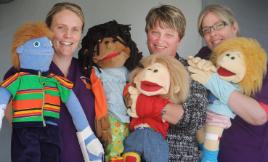Puppets play fun role in serious research project
Published on 16 November, 2012
A team of Rockhampton Hospital nurses hope their puppet play-time will put them on the map as far as paediatric nursing goes, with support from CQUniversity.
The team presented a progress report on their research at Rockhampton Hospital Academic Day recently.
The project, which was funded by CQUniversity, is the work of paediatric nurses Lea Veith, Bree Walker and Lori Nancarrow, and Uni reps Professor Kerry Reid-Searl (who also works as a paediatric nurse), Loretto Quinney, Professor Brenda Happell and Professor Ysanne Chapman.
Lori Nancarrow, Nurse Unit Manager of the Paediatric Unit, said the puppets worked well by helping young patients feel at ease in hospital and the team hoped to gather evidence to support the positive outcomes they gained.
Puppets have been used widely for play and education, but there is a lack of literature to explain a framework to guide nurses using them in a paediatric context.
There are three main puppets in the team - Tommy, Florence and Harry. All have distinct personalities, diagnoses, charts and medication records.
They are used to demonstrate medical procedures, such as how to use Ventolin spacers; and they're particularly friendly with children with a chronic illness who get to know them well.
Nurses use a procedural puppet called Frankie to show children what will happen when they have an invasive procedure such as an intravenous infusion.
"The child can insert the IV into the procedure puppet, they can put a catheter in or cannulate," Lori said. "It gives them a bit of control and means they're less fearful. We've had patients with cannulas inserted into one arm while they're interacting with the puppet and a nurse and they haven't even known. It's a great diversion."
This is a joint project between CQUniversity and Rockhampton Hospital. All of the hospital-based research team members are experienced paediatric nurses who love children and are keen to make a difference.
"One bad experience can ruin it for a child forever and if we can stop that trauma we can't really ask for more than that," Lori said.
When their research is complete the team members hope to have it published in journals and come up with a framework for the use of puppets in a proved evidence-based way, so the initiative may catch on in other paediatric units around the world.
"We really want to go overseas and the opportunity of presenting at an international conference is very exciting," Lori said.
"This really highlights what can be achieved in regional areas."
Kerry, Lori and Bree enjoyed sharing their research progress with colleagues at the third annual Academic Day.
Dr Beres Joyner has worked hard to coordinate the Academic Day for the third year in a row.
She said staff from different clinical streams including doctors, nurses and allied health professions presented research and papers done throughout the year.
The objectives of the day are to:
showcase peer reviewed research and conference presentations
provide opportunity for staff who are undertaking research to discuss their work in progress
to demonstrate to other Queensland Health staff what can be done or achieved at this facility
to demonstrate the calibre of health professionals employed at Rockhampton Hospital
to demonstrate to potential research partners that Queensland Health supports and promotes research.


